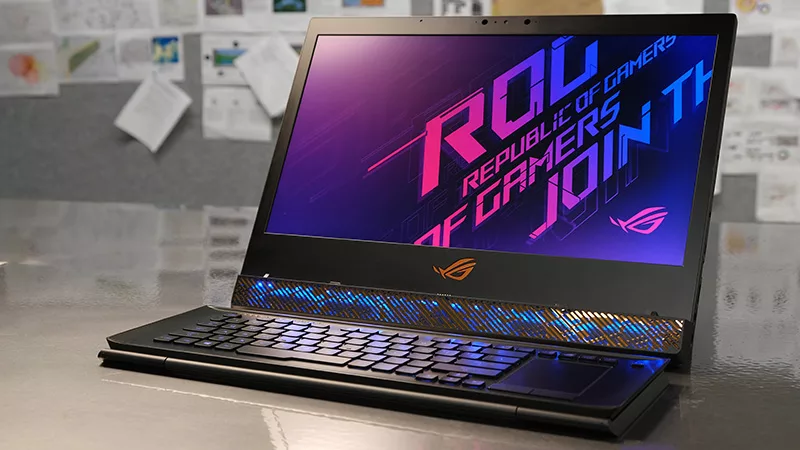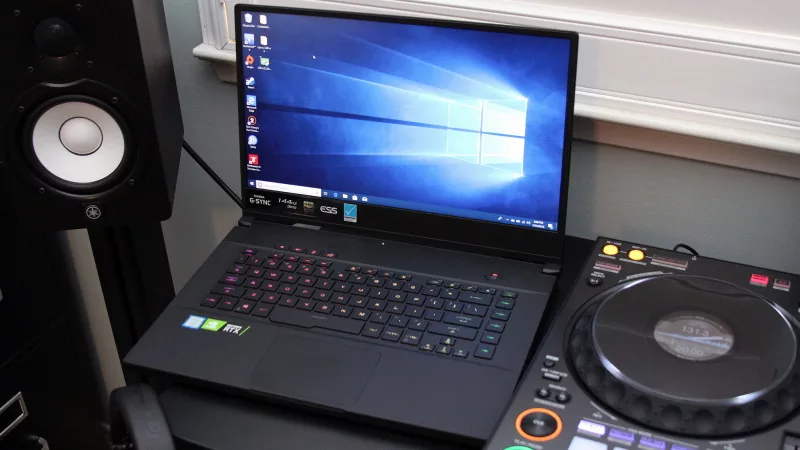Mobile Melee: GTX versus RTX in the ROG Strix Scar II
If you’re a gamer, you’re likely already familiar with NVIDIA’s new GeForce RTX graphics processors. Based on the new Turing architecture, they feature upgraded CUDA cores for programmable shading, plus RT cores real-time ray tracing, and Tensor cores for AI acceleration. Combining these cores enables more realistic reflections, lighting, and shadow effects that promise a more lifelike gaming experience in titles that take advantage, and developers are already working to incorporate RTX effects into new games.
For most people, this kind of upgrade is a big decision, so it can be difficult to weigh the benefits of investing early versus waiting. Luckily, some games already leverage this new tech, so it’s possible to compare and contrast the experience you’d have with one versus the other. Here at ROG, we’re keenly equipped to run a direct comparison of two matching laptops with different GPUs.
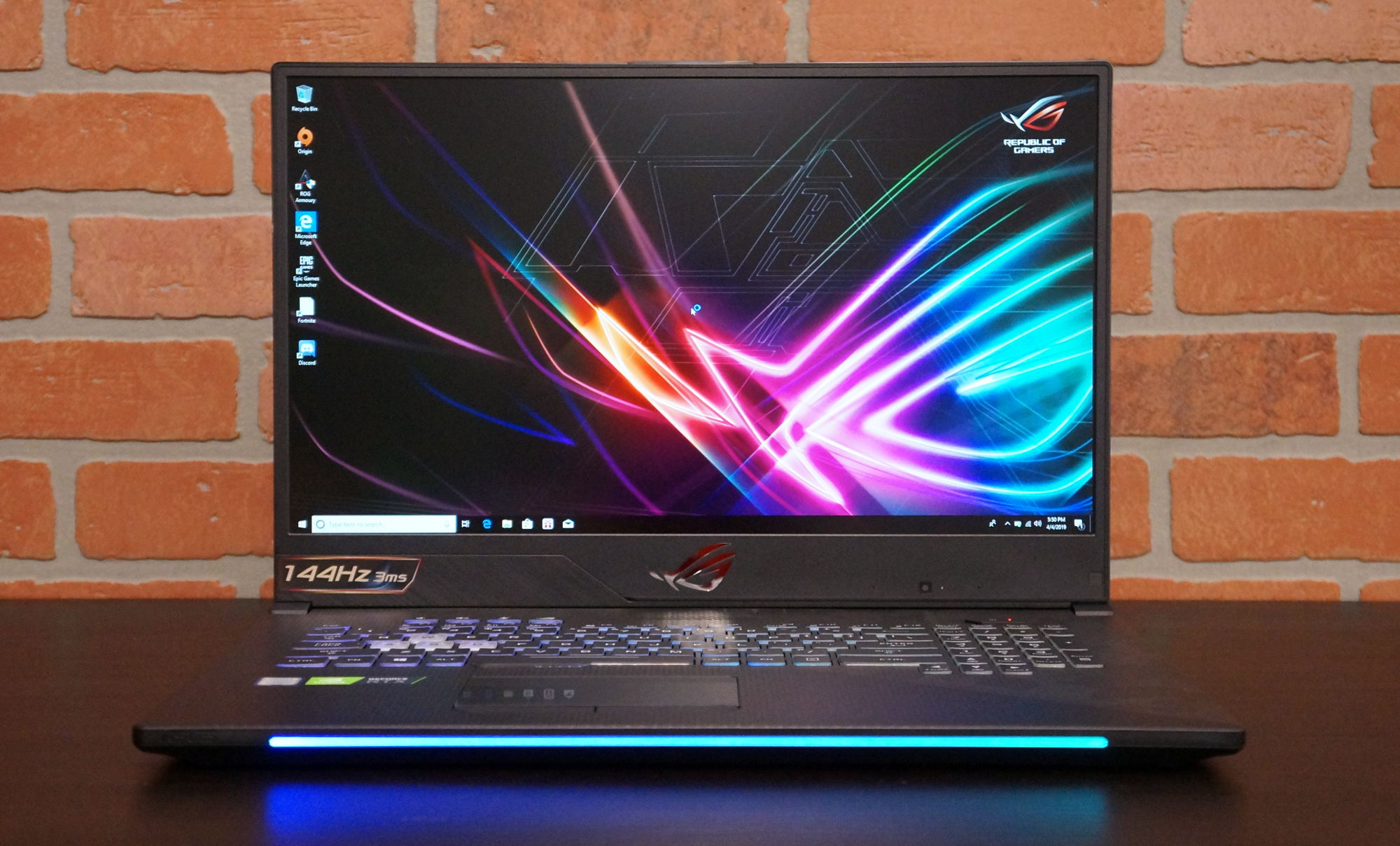
Earlier this year, we refreshed our entire ROG laptop family with RTX graphics, including the Strix SCAR II GL704. This laptop is proof that mobility doesn’t have to mean compromising on an immersive experience. With a high-end CPU, powerful GPU, blazing memory subsystem, and comprehensive I/O, it can handily go toe-to-toe with desktop PCs that never get out of the house. Add in a gorgeous IPS-level panel with a 144Hz refresh rate that translates all of that brawn into low-latency gaming, along with thin bezels for a svelte form factor sure to turn heads, and you’ve got a recipe for gaming greatness.
We were pretty enamoured with the Scar II when it debuted last year toting a trio of options for with GeForce GTX graphics. We handily plowed through popular titles like Battlefield V and Tom Clancy’s The Division 2 when we benchmarked the original GL704, but we wanted to see how performance would change with the addition of RTX graphics, so we pitted the Scar II against itself in a slate of tests to show off the difference in performance you can expect with RTX graphics.
Maximum performance with no wasted space
Despite powerful internals and an expansive 17” display, the GL704 is housed within a chassis that’s travel friendly. Gaming laptops need space inside to blow air across their high-wattage CPU and GPU, which often means thermal performance is prioritized at the expense of a chassis you can comfortably tote around. Our ROG Strix SCAR II leverages an effective cooling solution to pack powerful hardware into an enclosure that measures just over 1” thick. I found that the GL704 was small enough to slip into a backpack for mobile gaming at a coffee shop with room to spare for my notes, the power adapter, and my favorite mouse, the ROG Gladius II.
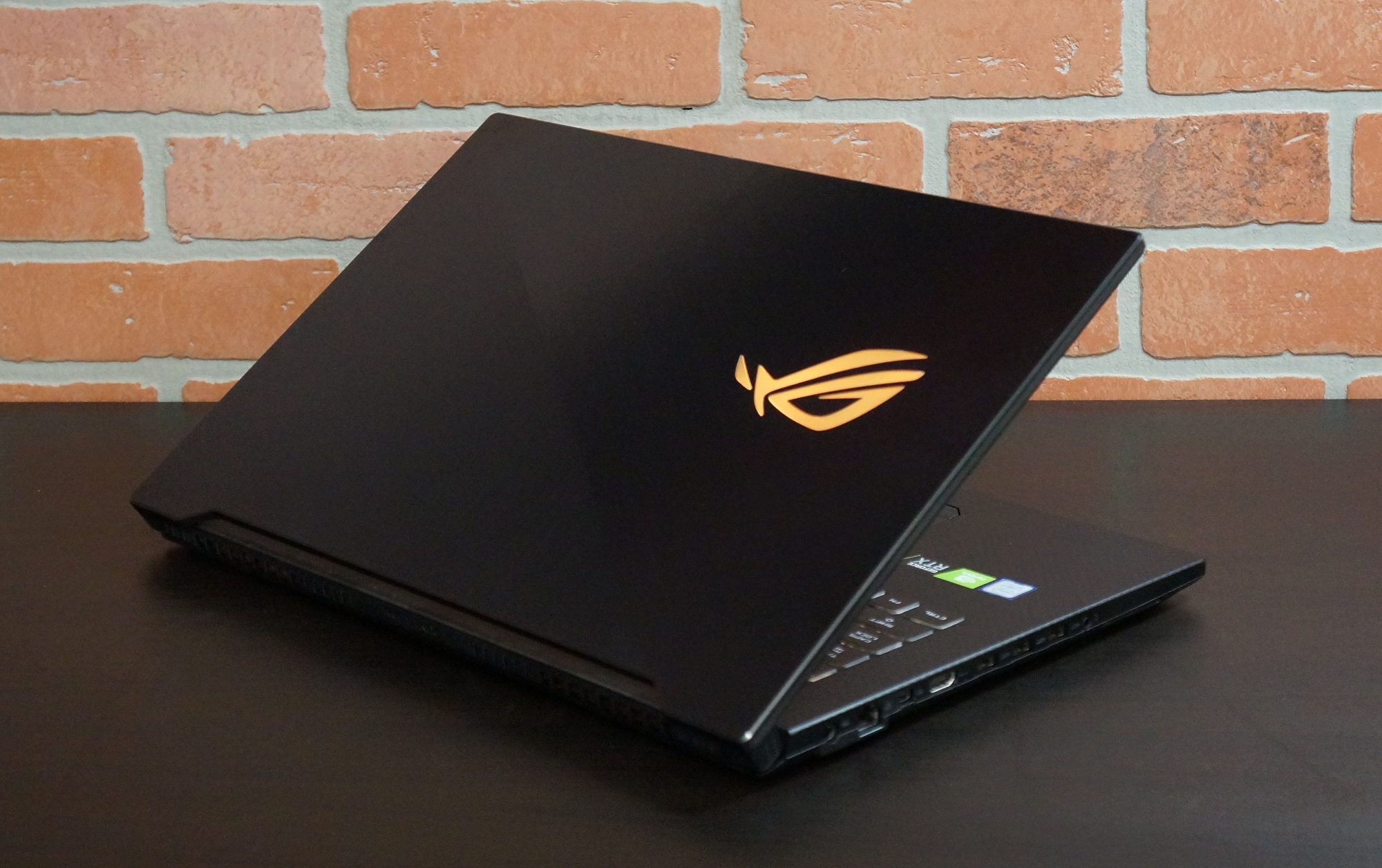
A slim build is only part of the equation when it comes to working on the go. Just as important is how much space the laptop takes up when you set it on the table. The GL704 fits a 17” panel into a 15.7” wide body thanks to incredibly slim bezels. At 7 mm each, the top and side borders are up to 50% smaller than other 17” gaming laptops. And in this case, less is more. Not only do they facilitate a design that’s truly mobile, but they also allow the big display to take center stage. Once again, we worked closely with AU Optronics, which created an IPS-style AVHA panel with a native resolution of 1920x1080. It’s able to reproduce 100% of the sRGB gamut, making the display ideal for gaming under the DirectX/Vulkan APIs. Moreover, a 144Hz refresh and 3ms pixel transition time give you the fastest possible response during competitive esports matches. Those specs also help eliminate tearing in fast-paced action games like Wolfenstein II: The New Colossus.
Guts and Glory
Of course, the only way to take advantage of a performance-oriented display is with a fast graphics processor. I got my hands on two versions of the SCAR II—one with NVIDIA’s latest Turing-based GeForce RTX 2060 6GB and the other with a GeForce GTX 1060 6GB. Both mobile solutions are based on the same GPUs as their desktop counterparts, giving them plenty of muscle to drive a Full HD panel. They can even keep up with the latest VR head-mounted displays. Both ROG Strix SCAR II laptops I tested had an 8th-gen Intel Core i7-8750H under the hood alongside 16GB of RAM. Wielding six cores and 12 threads (thanks to Hyper-Threading Technology), the Intel Core i7-8750H features 9MB of cache and a 4.1GHz maximum Turbo Boost frequency. It’s definitely a computing beast.
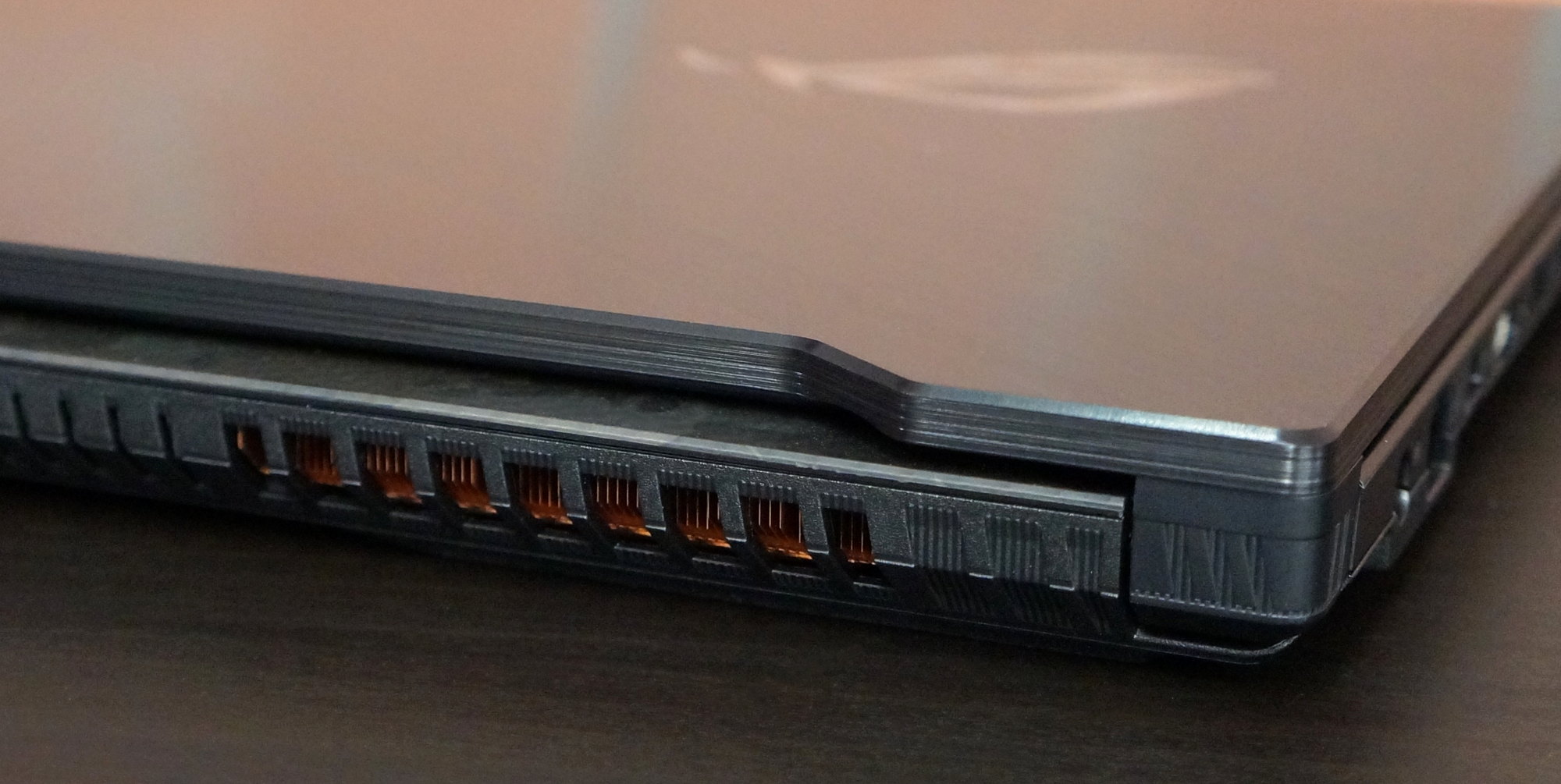
High-end components require special considerations for cooling, particularly in a laptop touting such a slim build. The SCAR II employs our HyperCool Pro system, comprising a pair of powerful 12-volt fans and three heat sinks. One sink is dedicated to NVIDIA’s GPU, while the other two cooperatively cope with workloads that tax other platform components. If you’re rendering video in Adobe Premiere, both heat sinks help keep Intel’s Core processors nice and cool. The sinks are lined with thin copper fins, increasing the thermal solution’s overall surface area and improving its performance. The 12V fans are able to blow more air through the fins than the 5V fans used in many other notebooks, and special air channels resist dust build-up, ensuring the heat sinks stay unobstructed over time.
Touch the rainbow
Beyond its desktop-like performance and functionally good looks, the GL704 is also comfortable to use. Thanks for that goes to an especially responsive keyboard. The mushiness you might expect from laptop keys is replaced by plenty of bottom-out travel for an improved typing experience. Moreover, the SCAR II utilizes overstroke technology to register input halfway through each key’s 1.8mm of travel. This results in a shorter delay between your finger’s movement and action on-screen, and it’s particularly helpful in fast-paced games reliant on reaction time to pull off attacks and avoid damage.
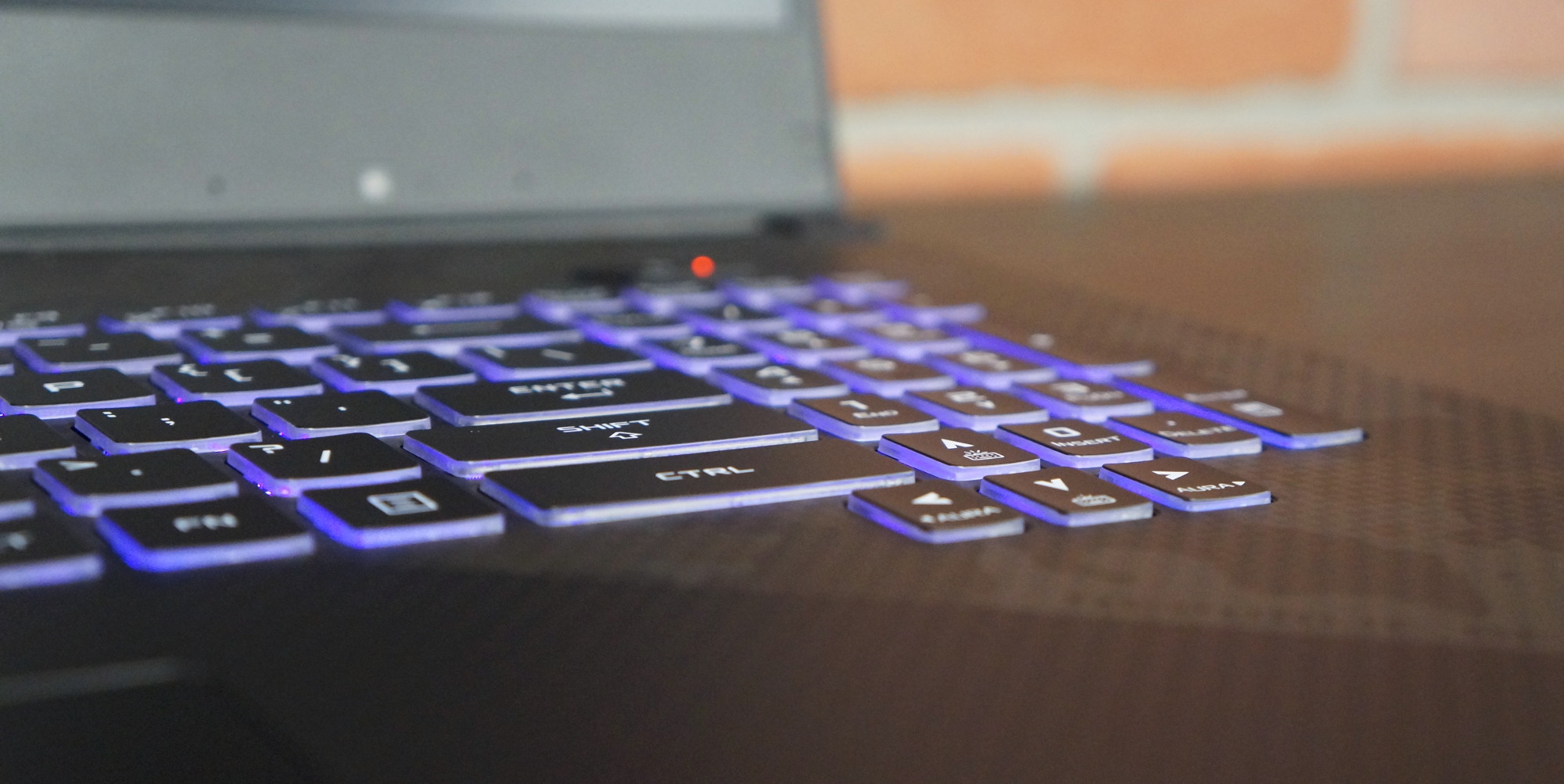
The keys are easier to see, too. All of them benefit from four-zone RGB lighting and extended translucent edges, which lets more light through for a stylish glow effect across the keyboard. Completely translucent caps on the W, A, S, and D keys mean those shine the brightest so you’ll never line your hand up on the wrong row during battle. A traditional desktop-style layout puts keys right where you expect them, including a number pad off to the side. The enlarged space bar is easier to strike quickly, while dedicated hotkeys facilitate easy volume and mic adjustments. I found it especially convenient to map game macros to the number pad keys, giving me fast access to complex sequences with minimal effort.
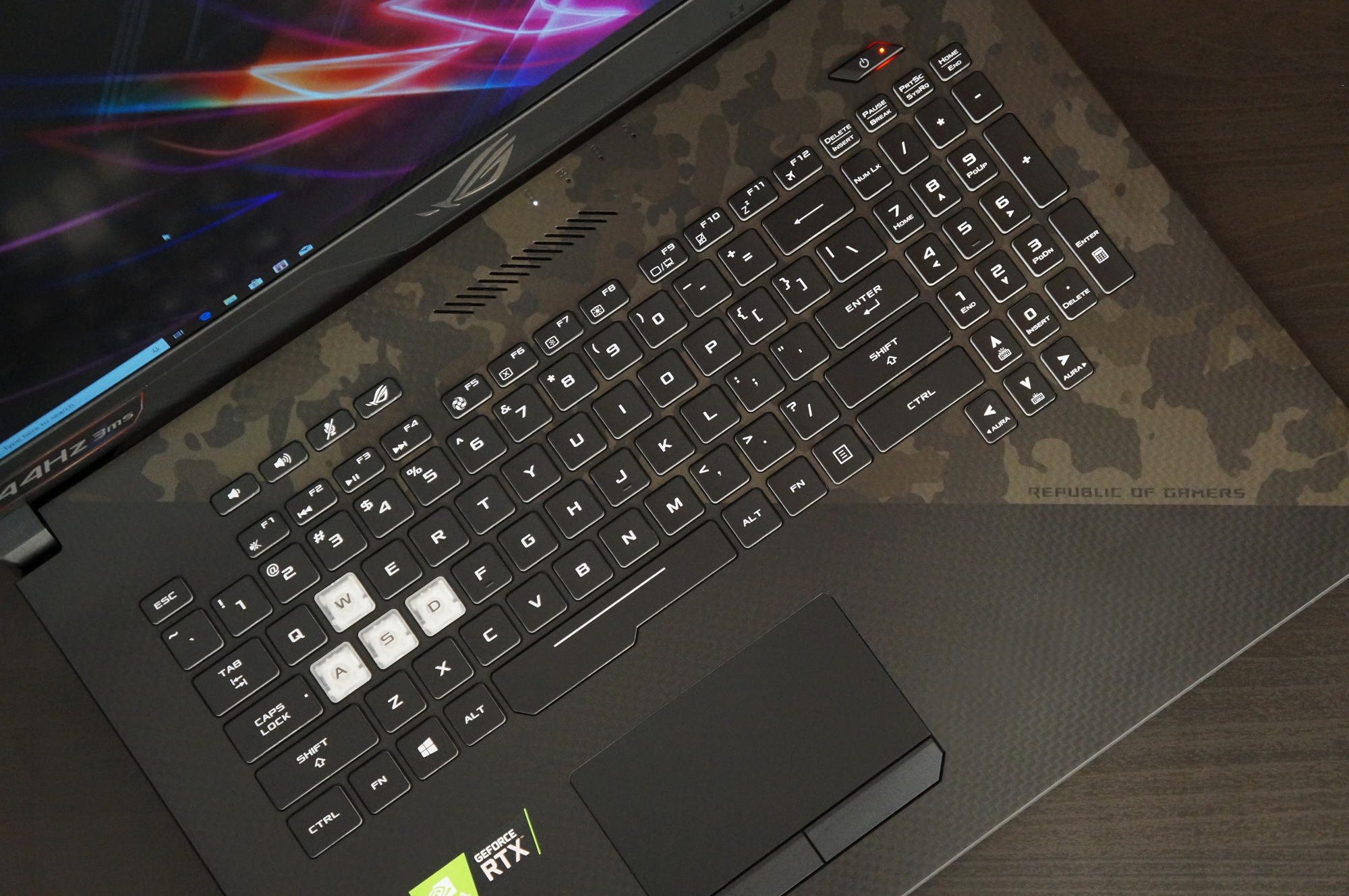
Spacing between the GL704’s keys is just right. To test this, I swapped back and forth between my desktop PC to the ROG Strix SCAR II with minimal adjustment time. The included Armoury Crate software allowed me to dial in specific profiles on a per-game basis, matching configurations I was already used to on other PCs. Armoury Crate also unifies lighting control and hardware monitoring, providing a single interface for controlling the GL704’s aesthetics, performance, and acoustics. I was able to synchronize the laptop’s light bar and ROG logo to my Gladius II Origin gaming mouse and ROG Strix Fusion headphones with just a few clicks.
Rubber meets the road
Handsome design, thin bezels, and impressive specs mean little if the benchmarks aren’t compelling. Fortunately, the HyperCool Pro system serves its purpose dutifully, allowing the Core i7 and GeForce to realize their potential across the swath of games we use for testing. We measured the performance of both samples in five different titles, most of which fall into the first-person shooter category. All of them are decidedly AAA-quality and capable of pushing graphics subsystems to the brink with demanding detail settings. OCAT and PresentMon were used to capture individual frame times of a 60-second clip, and we translated that data to FPS for easy interpretation. Faster performance produces more frames, which is why you see a difference in the lengths of the plots below.
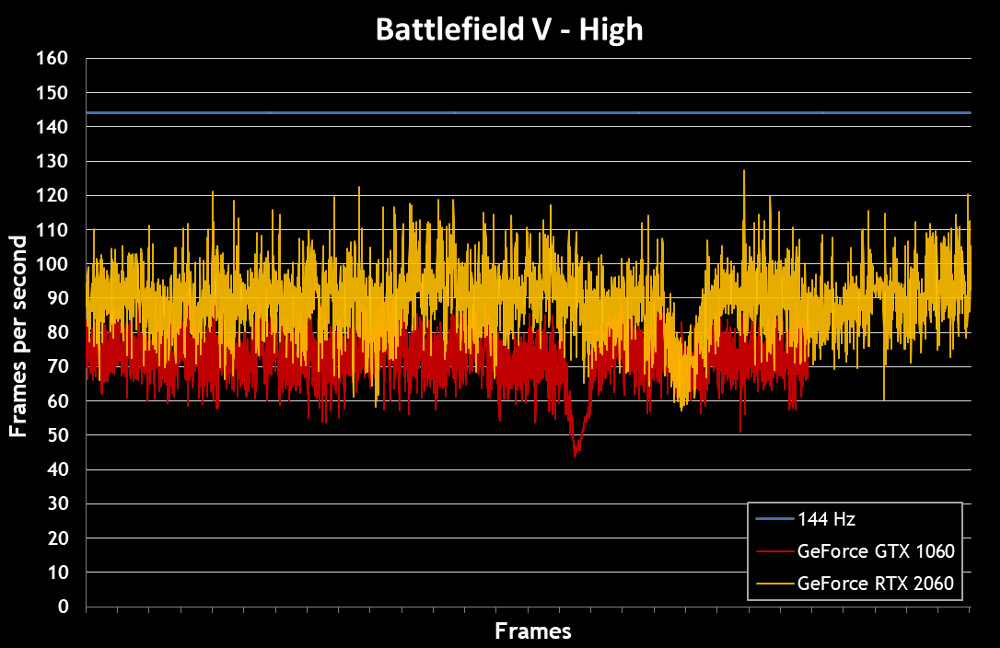
Battlefield V runs smoothly at 1920x1080, regardless of whether you game on a GeForce GTX 1060 or RTX 2060. Stepping up to the newer GPU does yield a 22% speed-up, pushing average frame rates from 70 FPS to roughly 86 FPS under the High detail preset.
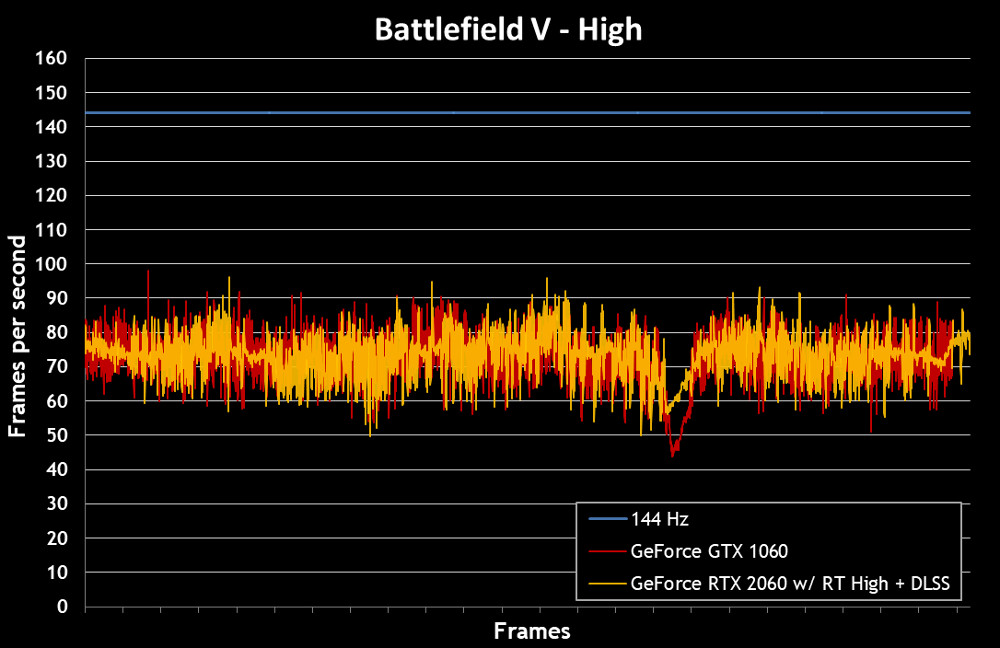
Here’s the thing, though: Battlefield V is one of a handful of games optimized for NVIDIA’s RTX technologies, including real-time ray tracing and deep learning super sampling (DLSS). Ray-traced reflections in Battlefield add an entirely new dimension to the game, making it much more beautiful. Meanwhile, DLSS leverages the Turing architecture’s AI-accelerating Tensor cores to improve frame rates. Enabled together, DLSS helps offset the performance cost of ray tracing. In our tests, the GeForce RTX 2060 with both technologies turned on gave us a two percent-higher average frame rate than the GTX 1060 without them.
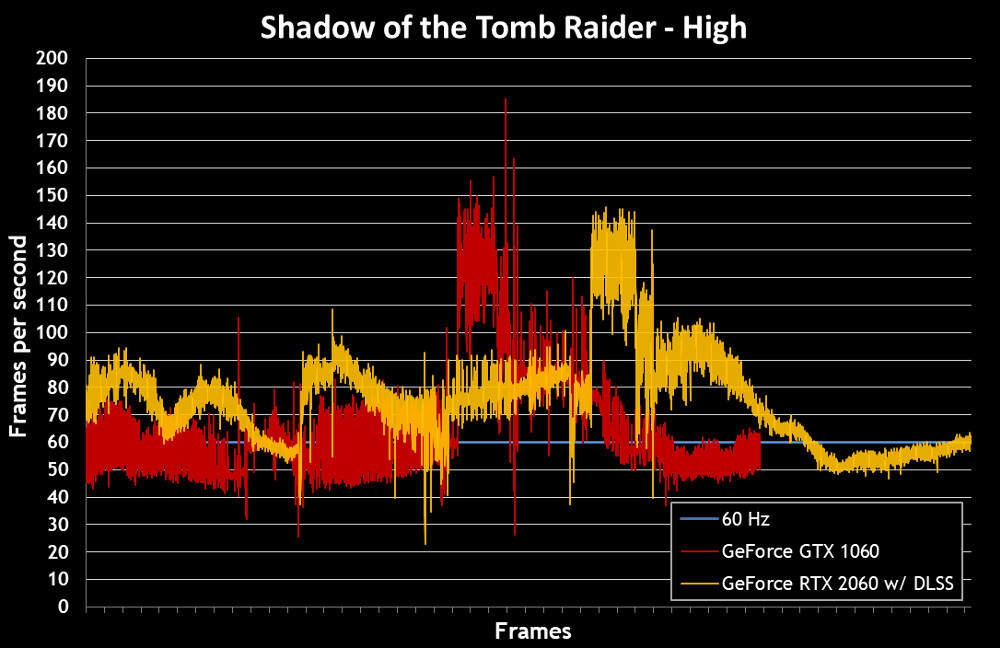
Eidos Montreal recently added RTX optimizations to Shadow of the Tomb Raider, making it possible for us to enable DLSS for improved frame rates on the GeForce RTX 2060. An average rate that exceeded 70 FPS was exceptionally smooth on the SCAR II’s high-refresh panel. But the GTX 1060 also gave us an enjoyable experience that averaged right around 60 FPS.
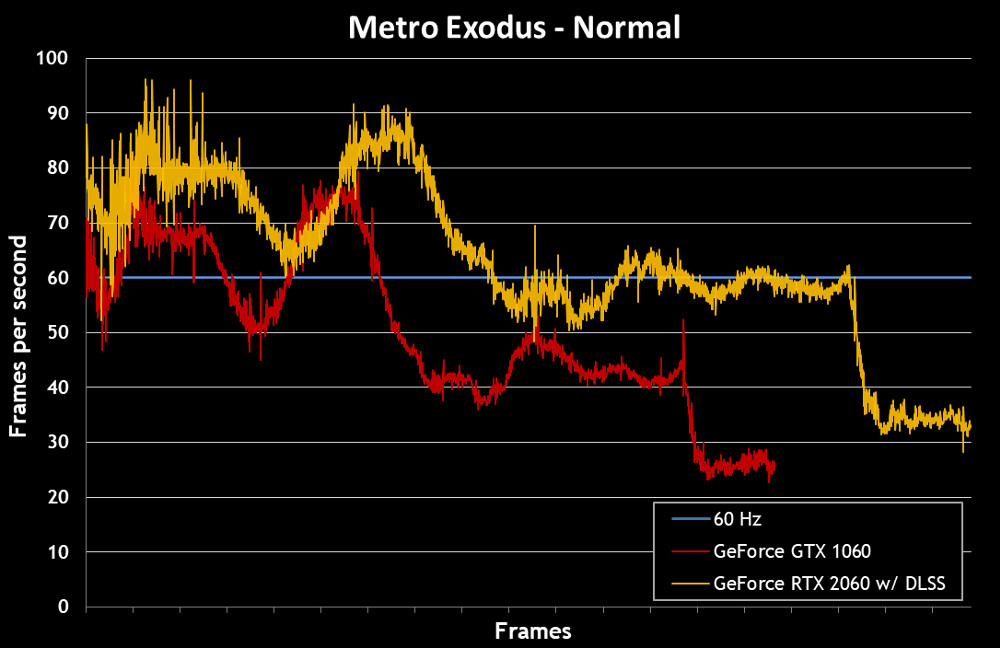
Metro Exodus is quite a bit more taxing, even at its Normal quality preset. The 46 FPS we averaged through its built-in benchmark on the GTX 1060 was still playable, since Metro isn’t especially fast-paced. However, running the sequence on the RTX GPU with DLSS turned on helped boost frame rates quite a bit. A 28% speed-up translated into a 59 FPS average.
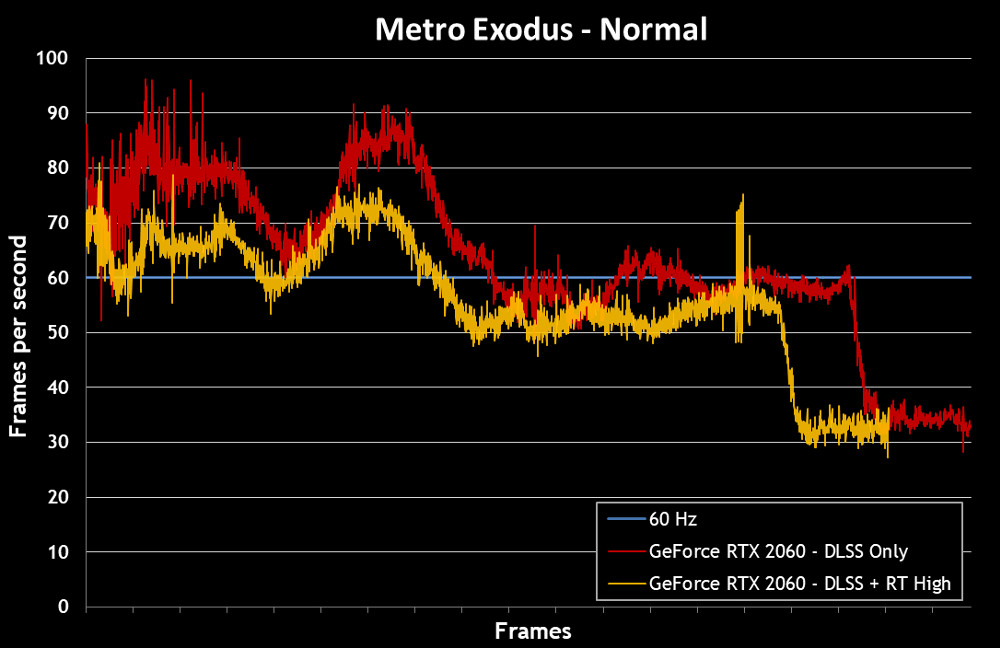
But if you really want to enhance Metro’s spooky atmosphere, you owe it to yourself to enable ray-traced global illumination on the GeForce RTX 2060. Again, this is an immensely demanding feature, requiring a Turing-based GPU capable of performing the requisite calculations on its RT cores. Thanks to the performance-enhancing effect of DLSS, though, the SCAR II maintains an average of 53 FPS with ray tracing set to High. Not long ago, real-time ray tracing was but a pipe dream in any form factor. Now it’s possible to enjoy the technology at playable frame rates on a laptop. Crazy.
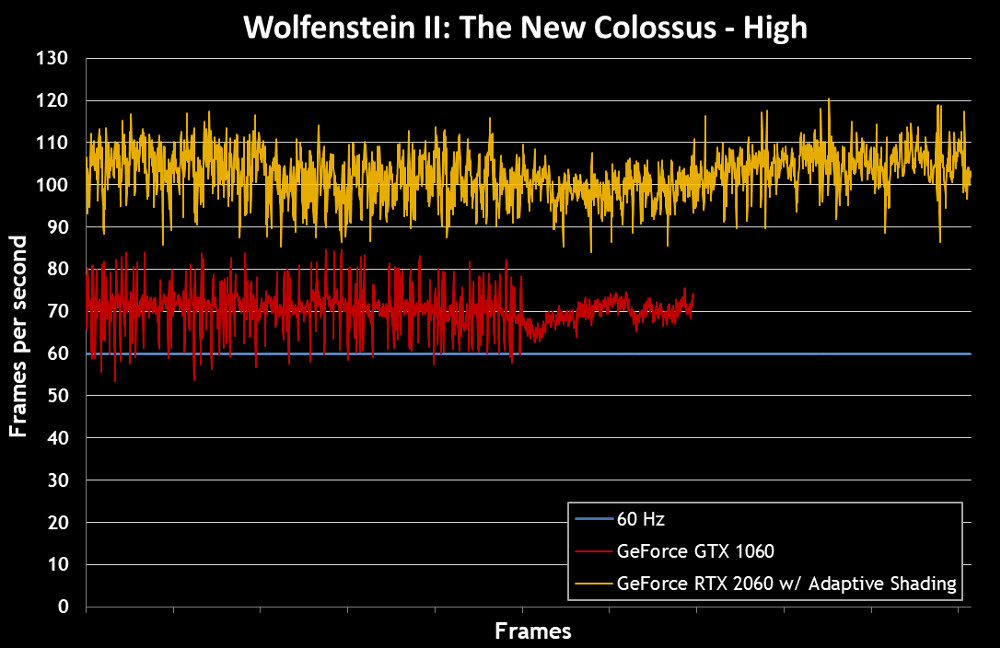
While ray tracing and DLSS are the Turing architecture’s highest-profile features, NVIDIA’s design also supports a handful of algorithms that improve the intelligence of shading operations. Wolfenstein II: The New Colossus is the first game optimized for these technologies, which focus fewer shading resources on objects moving across the screen quickly or rendered in lower detail. As a result, our RTX 2060 laptop enjoys a huge performance boost with NVIDIA Adaptive Shading set to Balanced. Whereas the GeForce GTX 1060 offers a fluid 70 FPS through our benchmark, its RTX counterpart exceeds 100 FPS. That’s a 46% increase thanks to Turing’s enhancements.
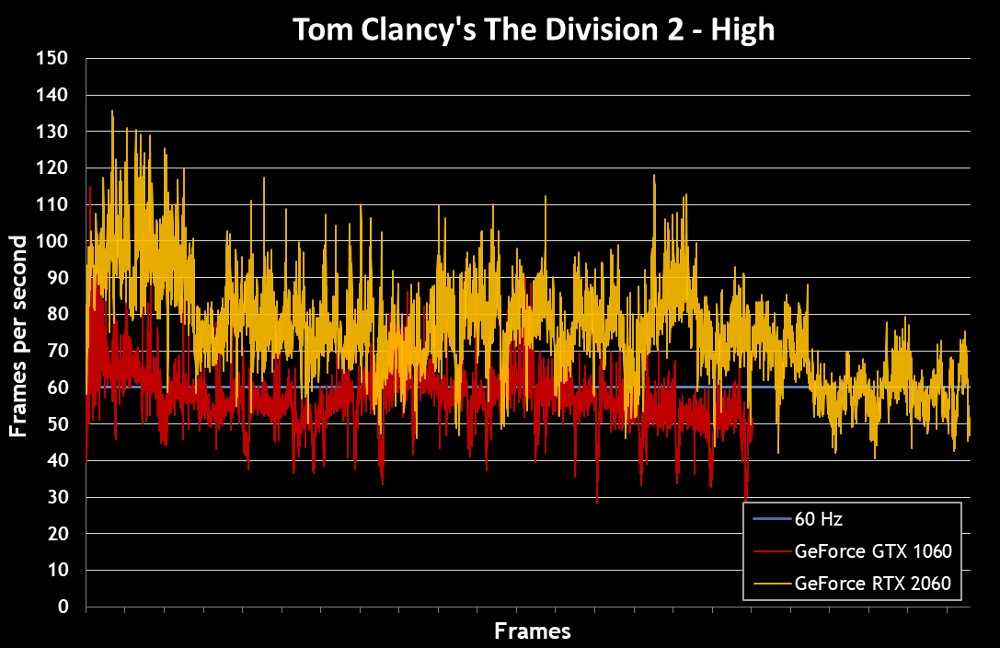
Tom Clancy’s The Division 2 doesn’t favor any particular hardware design, so the GTX 1060 and RTX 2060 are on equal footing with regard to the features they support in this game. The 1060 facilitates a smooth experience at the SCAR II’s native resolution of 1920x1080 using the High quality preset. But the 2060 and its augmented CUDA cores, larger caches, and massive memory bandwidth drive a 31% speed-up to average 70 FPS.
Playable performance at native resolutions is the goal of any gaming notebook, and the ROG Strix SCAR II proves itself capable of satisfying this requirement across our enthusiast-oriented benchmark suite. Rest assured that competitive esports gamers will enjoy even higher frame rates in those faster-paced titles. The GeForce GTX 1060 6GB-equipped GL704GM serves as a fantastic baseline for gaming on the go. Meanwhile, enthusiasts with an eye for realism can look to the GL704GV. Not only does it bump graphics horsepower up a notch in traditionally rasterized games, but the system’s GeForce RTX 2060 uniquely supports future-looking technologies like real-time ray tracing, DLSS via NVIDIA’s Tensor cores, and Variable Rate Shading.
Stay cool and game on
More so than any other mobile workload, intense gaming sessions heat up the SCAR II’s host and graphics processors. We used AIDA64 Engineer to collect thermal and utilization data for the Core i7-8750H and GeForce GTX 1060 6GB.
For a brief moment during an hour-long Fortnite session, the Core i7 hit 81°C . Otherwise, it never really spent any significant time above 76°C. Average utilization just under 25%, peaking at 63%, tells us that the beefy six-core chip had plenty of headroom left over for other tasks, like streaming to online platforms like Twitch and YouTube.Meanwhile, NVIDIA’s GPU handled the heavy lifting. It was fully utilized (99%) through our gaming session, but only averaged 90% utilization due to downtime between matches. A 70°C maximum was well below the GP106 processor’s ceiling, and an average of 60°C through the test sequence highlights the effectiveness of ROG’s HyperCool Pro technology.
An unforgettable supporting cast
Although the Core i7 and GeForce contribute most to the SCAR II’s performance, they’re reliant on a platform able to fetch data quickly. Both of our samples wielded 16GB of DDR4-2666, matching some of the fastest gaming desktops out there. Across its two memory channels, the GL704 is configurable with up to 32GB of RAM if your rendering projects require even more capacity.Outside of graphics, storage is the only other area these twins differ. Tiered storage on the GTX 1060 model balances quick transfer rates, keeping level load times to a minimum with lots of room for data. A 256GB NVMe-based SSD played host to Windows 10 and our benchmark suite, while movies, music, saved games, and render projects lived on the roomier 1TB hard drive. The RTX 2060 version goes all in on SSD storage with a 512GB NVMe-based SSD that allowed us to stash everything on one blazing fast drive.

Ample connectivity makes it easy to get files on or off those storage devices, connect external displays, attach gaming peripherals, and hook up to gigabit-class networks. A single Type-C port offers USB 3.1 Gen 2 data rates up to 10 Gb/s. It also supports our ROG Delta Type-C-attached headphones, if you’re looking to move away from the aging 3.5mm combo jack. Three USB 3.1 Gen 1 ports and one USB 3.1 Gen 2 interface accommodate keyboards, mice, phone chargers, and power banks. Mini-DisplayPort 1.2 and HDMI outputs let you dock up to even larger monitors once you get back to home base. Moreover, integrated Ethernet and 802.11ac 2x2 controllers facilitate gigabit-class communication with wired and wireless networks.

A symbol of strength
Exuding style, serving up flexibility and customization, and representing a series of smart hardware decisions, the ROG Strix SCAR II GL704 is an ideal option for gamers looking for an experience that’s more immersive without sacrificing portability. The Scar II packs high-end hardware into a truly mobile form factor, and its potent specs are cooled expertly, ensuring performance never falters during the heat of battle. Sitting inches away from a large 17.3” display really draws you into the gaming experience, while tiny bezels minimize the GL704’s footprint when it’s time to pack up and travel. A native resolution of 1920x1080 is the right choice to complement NVIDIA’s GeForce graphics subsystem, regardless of whether you spring for a GeForce GTX 1060 6GB or step up to the faster RTX 2060, which also unlocks more realistic RTX effects.
| ROG Strix Scar II GL704GV-DS74 | ROG Strix Scar II GL704GM-DH74 | |
|---|---|---|
| Processor | 8th Gen Intel Core i7-8750H | |
| Display | 17.3" IPS-type FHD (1920 x 1080) with 100% sRGB 144Hz refresh rate with 3ms GtG response time |
|
| Graphics | NVIDIA GeForce RTX 2060 8GB GDDR6 | NVIDIA GeForce RTX 1060 6GB GDDR6 |
| Memory | 16GB DDR4 2666MHz SDRAM | |
| Storage | 512GB M.2 NVMe PCIe SSD | 256GB PCIe SSD + 1TB HDD |
| Wireless | 802.11ac 2x2 Wave 2 Wi-Fi Bluetooth® 5.0 | |
| Connectivity | 1 x USB 3.1 Gen 2 Type-C, 3 x USB 3.1 Gen 1, 1 x USB 3.1 Gen 2, 1 x mini DisplayPort 1.2, 1 x HDMI 2.0, 1 x RJ-45 jack, 1 x SD card reader, 1 x 3.5-mm audio combo | |
| Audio | 2 x speakers with smart-amplifier technology Array microphone |
|
| OS | Windows 10 Home | |
| Size | 39.98 x 27.35 x 2.49~2.64 cm | |
| Weight | 2.9kg | |
| Price | $1,799 USD $2,299 CAD |
$1,699 USD $2,099 CAD |
| Availability (USA) | ASUS Store, Newegg, Best Buy, Amazon, Adorama, Fry's, ExcaliberPC, Mobile Advance, iBuyPower, XoticPC, HID Evolution, Pro Star | Newegg, Amazon, Mobile Advance, ExaciberPC, Best Buy, B&H, Micro Center, HID Evolution |
| Availability (Canada) | Newegg.ca, Canada Computers, Memory Express | Canada Computers, Amazon, London Drugs, The Source, Memory Express |
Gamers in North America can find the ROG Strix SCAR II GL704 at the retailers listed in the table above. If you’re outside of the US and Canada, check with your local ROG representative for availability and pricing in your region.
